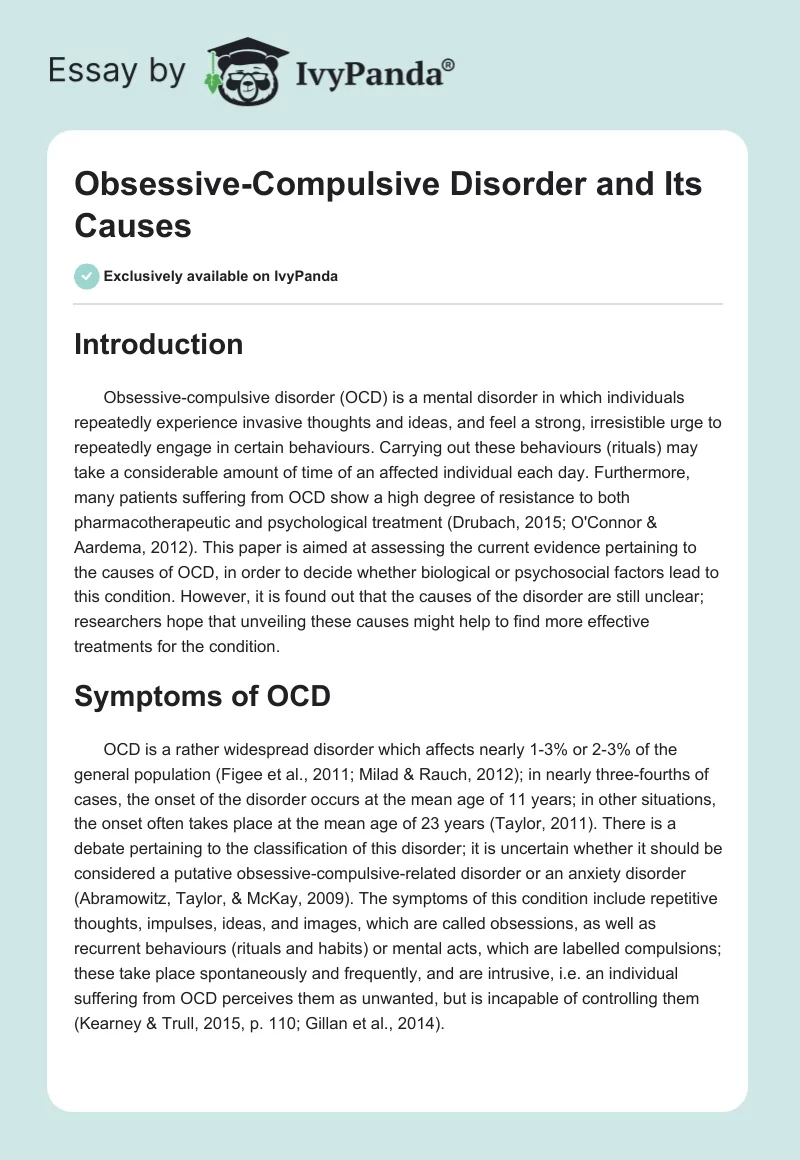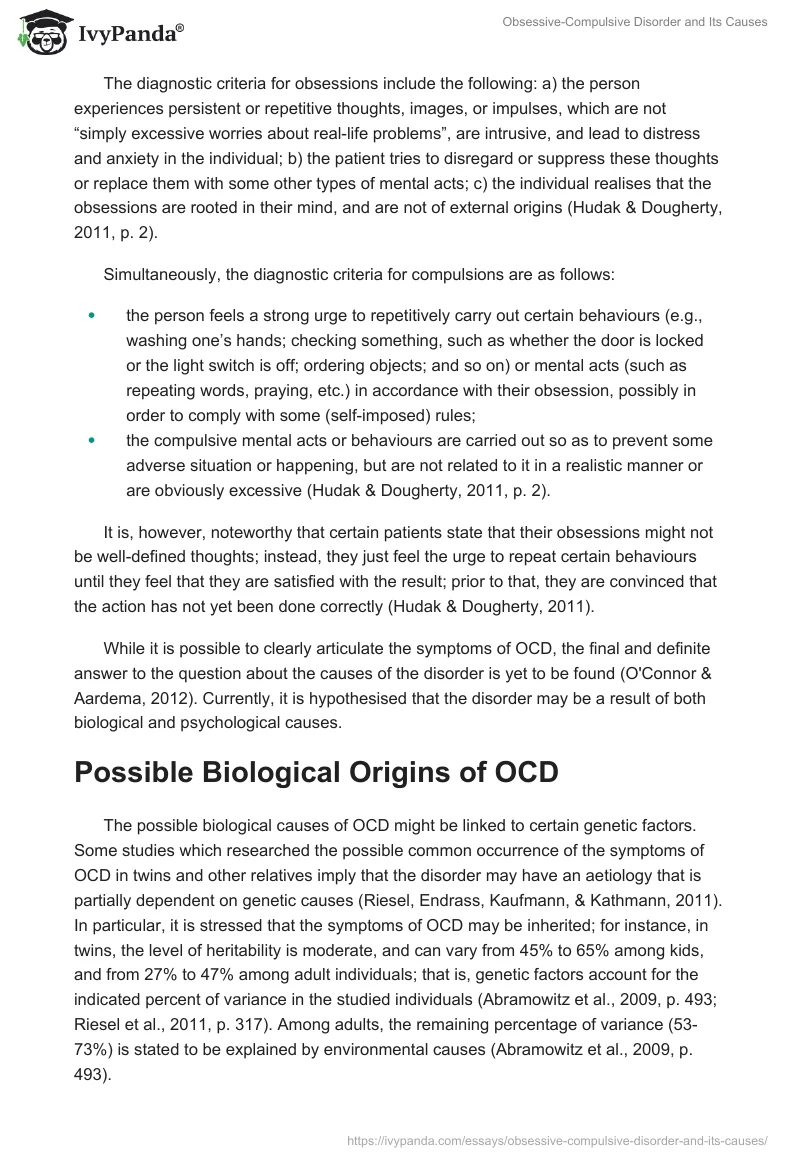Introduction
Obsessive-compulsive disorder (OCD) is a mental disorder in which individuals repeatedly experience invasive thoughts and ideas, and feel a strong, irresistible urge to repeatedly engage in certain behaviours. Carrying out these behaviours (rituals) may take a considerable amount of time of an affected individual each day. Furthermore, many patients suffering from OCD show a high degree of resistance to both pharmacotherapeutic and psychological treatment (Drubach, 2015; O’Connor & Aardema, 2012). This paper is aimed at assessing the current evidence pertaining to the causes of OCD, in order to decide whether biological or psychosocial factors lead to this condition. However, it is found out that the causes of the disorder are still unclear; researchers hope that unveiling these causes might help to find more effective treatments for the condition.
Symptoms of OCD
OCD is a rather widespread disorder which affects nearly 1-3% or 2-3% of the general population (Figee et al., 2011; Milad & Rauch, 2012); in nearly three-fourths of cases, the onset of the disorder occurs at the mean age of 11 years; in other situations, the onset often takes place at the mean age of 23 years (Taylor, 2011). There is a debate pertaining to the classification of this disorder; it is uncertain whether it should be considered a putative obsessive-compulsive-related disorder or an anxiety disorder (Abramowitz, Taylor, & McKay, 2009). The symptoms of this condition include repetitive thoughts, impulses, ideas, and images, which are called obsessions, as well as recurrent behaviours (rituals and habits) or mental acts, which are labelled compulsions; these take place spontaneously and frequently, and are intrusive, i.e. an individual suffering from OCD perceives them as unwanted, but is incapable of controlling them (Kearney & Trull, 2015, p. 110; Gillan et al., 2014).
The diagnostic criteria for obsessions include the following: a) the person experiences persistent or repetitive thoughts, images, or impulses, which are not “simply excessive worries about real-life problems”, are intrusive, and lead to distress and anxiety in the individual; b) the patient tries to disregard or suppress these thoughts or replace them with some other types of mental acts; c) the individual realises that the obsessions are rooted in their mind, and are not of external origins (Hudak & Dougherty, 2011, p. 2).
Simultaneously, the diagnostic criteria for compulsions are as follows:
- the person feels a strong urge to repetitively carry out certain behaviours (e.g., washing one’s hands; checking something, such as whether the door is locked or the light switch is off; ordering objects; and so on) or mental acts (such as repeating words, praying, etc.) in accordance with their obsession, possibly in order to comply with some (self-imposed) rules;
- the compulsive mental acts or behaviours are carried out so as to prevent some adverse situation or happening, but are not related to it in a realistic manner or are obviously excessive (Hudak & Dougherty, 2011, p. 2).
It is, however, noteworthy that certain patients state that their obsessions might not be well-defined thoughts; instead, they just feel the urge to repeat certain behaviours until they feel that they are satisfied with the result; prior to that, they are convinced that the action has not yet been done correctly (Hudak & Dougherty, 2011).
While it is possible to clearly articulate the symptoms of OCD, the final and definite answer to the question about the causes of the disorder is yet to be found (O’Connor & Aardema, 2012). Currently, it is hypothesised that the disorder may be a result of both biological and psychological causes.
Possible Biological Origins of OCD
The possible biological causes of OCD might be linked to certain genetic factors. Some studies which researched the possible common occurrence of the symptoms of OCD in twins and other relatives imply that the disorder may have an aetiology that is partially dependent on genetic causes (Riesel, Endrass, Kaufmann, & Kathmann, 2011). In particular, it is stressed that the symptoms of OCD may be inherited; for instance, in twins, the level of heritability is moderate, and can vary from 45% to 65% among kids, and from 27% to 47% among adult individuals; that is, genetic factors account for the indicated percent of variance in the studied individuals (Abramowitz et al., 2009, p. 493; Riesel et al., 2011, p. 317). Among adults, the remaining percentage of variance (53-73%) is stated to be explained by environmental causes (Abramowitz et al., 2009, p. 493).
It is also highlighted that “evidence for susceptibility loci on chromosomes 3q, 6q, 7p, 1q, and 15q” was discovered, but that these results were not replicated in a consistent manner by other scientists; this may be remedied by identifying endophenotypes (trait markers) of the disorder, that is, “quantitative biological or cognitive traits that represent simpler clues to genetic underpinnings than the syndrome itself” (Riesel et al., 2011, p. 317). It is possible that the increased error-monitoring and the enhanced error-related activity of the brain might be used as such an endophenotype, for it was observed significantly more frequently in patients with OCD and their relatives in comparison to healthy individuals in the study by Riesel et al. (2011). Clearly, error-related activity is directly linked to the compulsions shown by the patients, that is, the need to repeatedly perform an action or repeat a procedure because the person feels that it has not been done properly (Hudak & Dougherty, 2011).
Neuropathophysiologically, OCD is associated with disruptions in the dopaminergic and serotonergic systems of the brain, in particular, with “hypersensitivity of postsynaptic serotonin receptors”; however, it is highlighted that studies tying these problems to particular genetic causes had been inconsistent (Abramowitz et al., 2009, p. 492). It might be observed that the symptom of compulsions–the need to repeat the behaviour until one feels satisfied that the action has been carried out properly–might be linked to dopaminergic activity, for dopamine is the substance which causes the feeling of satisfaction. In this respect, it is important to stress that OCD patients demonstrate weaker reward processing activity of the brain (Figee et al., 2011), which is what might cause them to feel unsatisfied until the behaviour has been repeated many times.
On the whole, however, it should be noted that because both OCD-affected individuals and their relatives show certain features which are directly linked to OCD (such as the mentioned increased error-monitoring), because it was found that the disorder has moderate levels of heritability, and because genetic factors account for a significant (even though moderate) amount of variance related to OCD in twins, it might be possible to conclude that OCD may be caused by genetic factors.
Possible Psychosocial Origins of OCD
It is stated that the cognitive-behavioural approach to identifying the possible psychological or psychosocial causes of OCD is one which has been supported with the largest amount of evidence among such models (Abramowitz et al., 2009).According to this approach, both obsessions and compulsions may have their origins in some kinds of dysfunctional beliefs. This model is based on the fact that in the overall population, the occurrence of undesired mental intrusions, such as unpleasant or repulsive thoughts or ideas, is not uncommon, and is, in fact, experienced by the majority of individuals; these intrusions are similar in content to the obsessions of people with OCD (Abramowitz et al., 2009).
For instance, an individual may have a thought or a mental image of a situation in which the members of their family are killed or mutilated; in most cases, such ideas will be dismissed as meaningless. However, the proponents of the cognitive-behavioural approach argue that the frequent occurrence of such intrusions may gradually result in the development of an obsession, when the individual experiencing these intrusions starts regarding them as threatening (as cited in Abramowitz et al., 2009). These obsessions, in turn, lead to the emergence of compulsive rituals, which might be aimed both at the removal of intrusion and at precluding the occurrence of the harmful event; the rituals then become persistent due to the fact that they reduce the amount of anxiety that an individual experiences (Abramowitz et al., 2009).
It is stressed that the cognitive-behavioural model of the development of OCD allows for explaining the width of the range of objects to which OCD might be related (Abramowitz et al., 2009); for instance, a person who is afraid of becoming diseased might develop the compulsion of repeatedly washing their hands. However, even though this model was supported by a number of studies, Abramowitz et al. (2009) points out that that it does not explain a large percentage of cases of OCD, in which persons “have essentially normal scores on measures of… [dysfunctional] beliefs” (p. 494).
Further Considerations
It should be noted that most of the literature found by the author of this paper was focused on biological causes of OCD. The evidence in the sources which were used also suggests that the disorder is highly likely to have roots in genetic factors. However, it is difficult to provide an explanation of OCD only using biological causes; in particular, it is still unknown how to explain the heterogeneity of obsessions and compulsions experienced by the patients with OCD (Abramowitz et al., 2009; Taylor, 2011). In addition, as has been noted above, genetic factors account for a statistically significant amount of variance in the occurrence of the OCD symptoms, but this amount is only moderate (Abramowitz et al., 2009, p. 493; Riesel et al., 2011, p. 317). Therefore, it might be most reasonable to consider OCD to be a disorder originating from both biological and psychosocial factors.
Conclusion
Therefore, the review of the current literature containing evidence pertaining to the aetiology of OCD revealed that currently, it is impossible to attribute this disorder to any particular factors. The studies which investigated the possibility of concrete genetic causes affecting the development of OCD have been inconsistent, even though such factors, on the whole, do explain a significant amount of variance in the occurrence of OCD. On the other hand, psychosocial factors, which also been supported by a number of studies, fail to explain the occurrence of the disorder in persons without dysfunctional beliefs. Therefore, it might be concluded that OCD may simultaneously be rooted in both genetic and psychosocial factors, although it is yet to be found out in which ones.
References
Abramowitz, J. S., Taylor, S., & McKay, D. (2009). Obsessive-compulsive disorder. The Lancet, 374(9688), 491-499. Web.
Drubach, D. A. (2015). Obsessive-compulsive disorder. Continuum: Lifelong Learning in Neurology, 21(3), 783-788. Web.
Figee, M., Vink, M., de Geus, F., Vulink, N., Veltman, Westenberg, H., & Denys, D. (2011). Dysfunctional reward circuitry in obsessive-compulsive disorder. Biological Psychiatry, 69(9), 867-874. Web.
Gillan, C. M., Morein-Zamir, S., Urcelay, G. P., Sule, A., Voon V., Apergis-Schoute, A. M.,…Robbins, T. W. (2014). Enhanced avoidance habits in obsessive-compulsive disorder. Biological Psychiatry, 75(8), 631-638. Web.
Hudak, R., & Dougherty, D. D. (Eds.). (2011). Clinical obsessive-compulsive disorders in adults and children. Cambridge, UK: Cambridge University Press.
Kearney, C. A., & Trull, T. J. (2015). Abnormal psychology and life: A dimensional approach. Stamford, CT: Cengage Learning.
Milad, M. R., & Rauch, S. L. (2012). Obsessive-compulsive disorder: Beyond segregated cortico-striatal pathways. Trends in Cognitive Sciences, 16(1), 43-51. Web.
O’Connor, K., & Aardema, F. (2012). Clinician’s handbook for obsessive compulsive disorder: Inference-based therapy. Chichester, UK: Wiley-Blackwell.
Riesel, A., Endrass, T., Kaufmann, C., & Kathmann, N. (2011). Overactive error-related brain activity as a candidate endophenotype for obsessive-compulsive disorder: Evidence from unaffected first-degree relatives. The American Journal of Psychiatry, 168(3), 317-324.
Taylor, S. (2011). Early versus late onset obsessive–compulsive disorder: Evidence for distinct subtypes. Clinical Psychology Review, 31(7), 1083-1100. Web.


